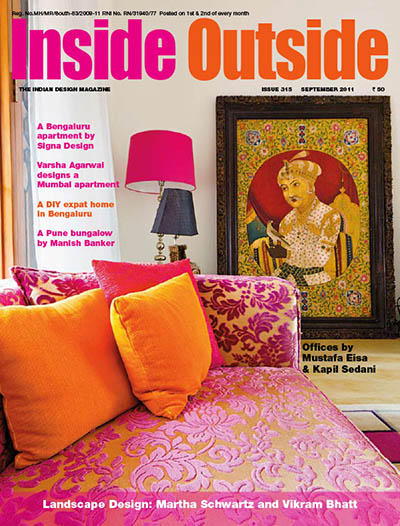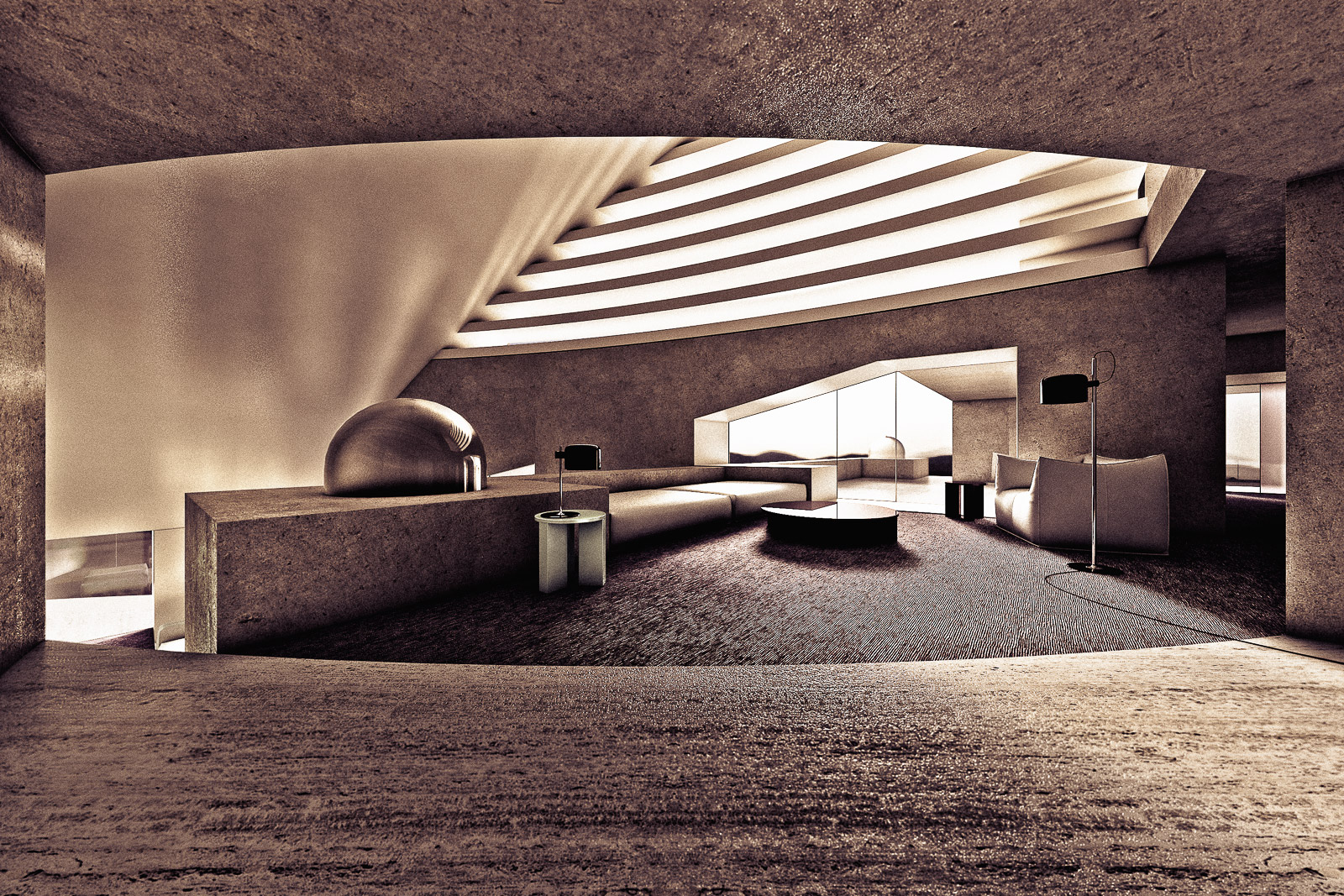
Review
Devyani Jayakar
Vaulted roofs and curved walls together with allusive references to the past, are the design signature of Italian architect Antonino Cardillo. His Purple House in Pembrokeshire, UK, is inspired by William Morris’ Red House built in 1859 in London, though it may be difficult to see the resemblance instantly, writes Devyani Jayakar.
Having featured the work of Antonino Cardillo several times before, let me summarise what he is all about, in my understanding. By now, Antonino’s signature geometries are quite recognisable. Vaulted roofs and curved walls with large expanses of glass, protected by a brise-soleil. An ‘untouchably’ immaculate interior which prescribes a certain lifestyle for the owner, is also an Antonino feature. He is passionate and intense about his work, to the extent that I suspect he probably hand picks his clients, choosing the ones he deems capable of living the kind of lifestyle his interiors demand—which, in effect, means that the umbilical cord is never cut. Rather like being able to ordain the traits of one’s offspring… who wouldn’t want to be able to do that? What fun!
At Inside Outside, we are unabashedly in favour of art, in the form of paintings, sculpture, artefacts and collectibles, which we are convinced breathe life and personality into any space. In my reckoning, there is very little architecture that would not be enhanced by the addition of these. So I reluctantly concede, that not only is Antonino’s strong architectural statement ‘complete’ without art, but that art may actually detract from its ‘look.’
A metaphorical reference to past architecture or a certain philosophy is usually part of Antonino’s intricate thought process, which can sometimes be obscure. Purple House has all the aforementioned characteristics of an Antonino Cardillo house, together with an allusive reference to the ‘Art and Craft’ Red House belonging to William Morris. Says Antonino, “It represents an attempt to re-experience the forgotten medieval Norman legacy in England, Wales and the Mediterranean region. Both Red and Purple House have in common the rediscovering of the middle-ages. But, differently from the nineteen century Red House in London which represents the search for a national British identity, my Purple House tries to recall the forgotten routes between Mediterranean and Britain shorelines, which during the middle-ages built the base of the modern western era. Therefore, if Red House is aimed at finding an identity, Purple House is aimed at discovering the influence of and interactions between diverse identities,” he says, adding, “Furthermore, the choice of the colour Purple is appropriate because it is an ambiguous colour and represents the melting pot of cultures suitably.”
Since Antonino identifies a particular home as inspiration for Purple House, I decided to find out what Red House was all about. A quick google search informs me that Red House, Bexleyheath London (1859), was designed for William Morris by architect Philip Webb. It exemplifies the early Arts and Crafts style, with its well-proportioned solid forms in red brick, wide porches, steep tiled roof, pointed window arches, brick fireplaces and wooden fittings. Webb rejected the grand classical style, based the design on British vernacular architecture and attempted to express the texture of ordinary materials, such as stone and tiles, with an asymmetrical and quaint building composition. It emphasises natural materials and is in a non-historical, domestic style.
So, I’m sticking my neck out when I make the following observations based on my marginal acquaintance with Red House: it doesn’t seem to have any vaulted roof, nor any curved walls—both signature ‘Antonino touches.’ Moreover, the Morris home seems to take the function of ‘shelter’ very seriously indeed, creating a protective cocoon around its inhabitants, impervious to the elements! The structure is more wall than window, unlike Antonino’s sweeping expanses of glass. Red House appears to be ‘closed in,’ rather than looking outwards, quite ponderous rather than uplifting, with very little fenestration compared to its expanse of brick walls. Although it is charming in a country-style way, I was not sorely tempted to pack my bags and move in there, regardless of my partiality to William Morris prints or stained glass. But all this is based just on viewing pictures on my laptop and personal taste, not an actual visit to the famous home.
The similarities that I could see, was Antonino’s glamorous brise-soleil (with all its dramatic light and shadow casting abilities) substituting for the traditional overhangs in Red House, and the overall irregular L-shape of the plan (pretty much standard for Antonino), which may not have any meaningful connection with the site itself in either Red or Purple House, but could be based more on whimsy. And maybe Antonino’s impressive, soaring vaulted roof which almost creates a personal sky in his interiors, is a substitute for the raftered roof in Red House. Not quite the same thing or effect, though. (Now Purple House with all its slick elegance, is a home I can see myself moving into, if only I could discipline myself to leave no signs of my occupation, which, as mentioned before, an Antonino structure certainly demands.)
So clearly, Antonino’s allusion to the older structure is more metaphorical than physical, its haute architecture making it a temple where Antonino pays his aesthetic respects to the Gods of Style. And what materials has Antonino used? As always, very few. Walls in lightweight concrete, purple carpeting and travertine stone for flooring, stucco for the vault, coloured metal for the brise-soleil and blind windows at the third level and clear glass with hidden frames as windows. The brief given by the client was concise: a house for a family, including a large hall able to receive many people and an ample private lounge at the master bedroom zone (boudoir). Carpet to be used as flooring and stone for high traffic areas such as stairs, hallway, kitchen, toilet and service closet.
Antonino describes this building: “Encircled by massive carved walls and coordinated by an interior symmetrical façade with crystal domes at the corners, the architectural forms investigate what unites us in this history. Compact, complex, oppressive, expressionistic, the hollow interior of this cave sculpture inhales light: a light which swells the curves and the bulkheads, it coagulates at the corners and slips away, amid the interstices. It brightens up an ample adamantine vault, creating shades and dilating it.
From dawn to dusk, its backlight changes the sense of space and the perception of the forms: at midday it dims the bulkheads curving in the living room. The light perforates the trapezoidal apertures carved in the heavy walls; close to the ceiling, the light transmutes itself into rapid blades cut by a magnified brise-soleil.
“At sunset, however, the hall darkens. The parts, now obscured, counterpoint distant glares spread around and inside the hollowed-out base: below a burning cave, above a giant brazier glows into the vault. During the course of a solar day, light and dark swap roles, interpreting the drama of architecture—monolithic and fragmentary, made of stone, cement and purple.”
Antonino adds, that from his first project—Let There Be More Light—he has always been interested in constructions which hold other constructions inside. “Here in Purple House, I tried to develop this concept to its maximum, creating a hollow base which is apparently independent from the rest of house, only to discover that it is the same house viewed from another side. I am really interested in this type of architectural ambiguity—apparently independent parts which reveal themselves subsequently as being part of a whole. I think this is like a metaphor of life…it so hard understand where life begins or ends,” he says.
Antonino has worked not only in his native Italy, but also in France, Spain, Australia, Japan (possibly the only place where he has departed from his beloved vaulted roofs and curved walls), and now in the UK. Not too many architects who specialise in homes are able to work in so many different countries. This is always easier for those involved in mega projects like urban planning and townships. About the construction aspect, Antonino says that he is used to working with local labour. “I am very enthusiastic about working everywhere in the world. I strongly believe that experiencing different sites enables me to learn more about different people and traditions. From my point of view, architecture is a pretext to learn about life. Each time, a new country or a new site reveals to me another tile of this complex mosaic called ‘the world,’” he says.

Antonino Cardillo, Purple House, Pembrokeshire, 2011.